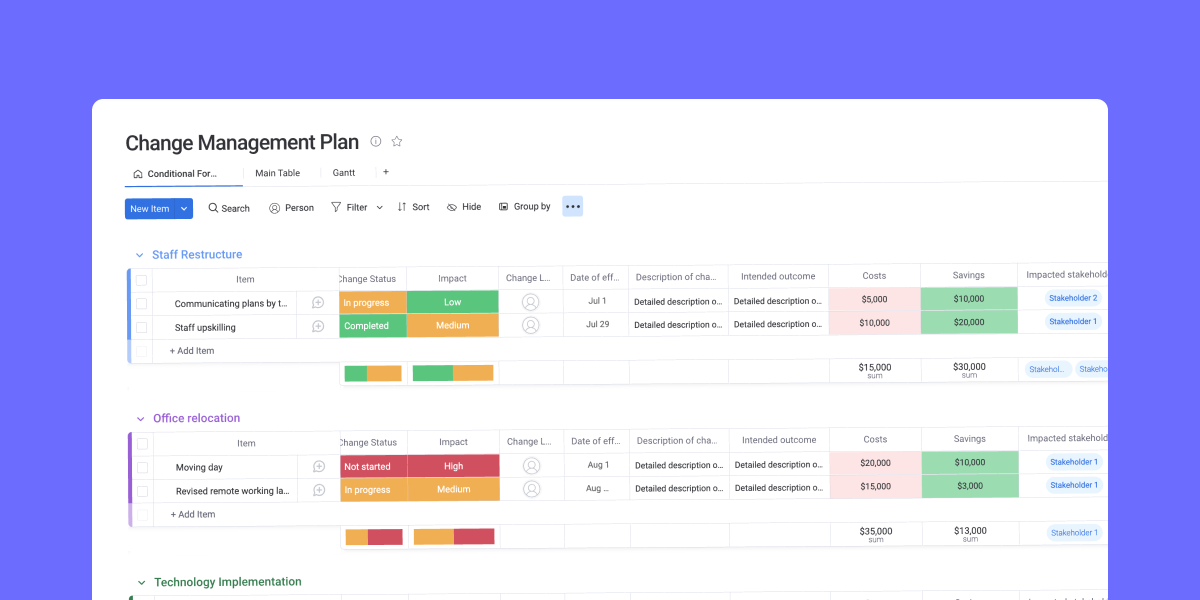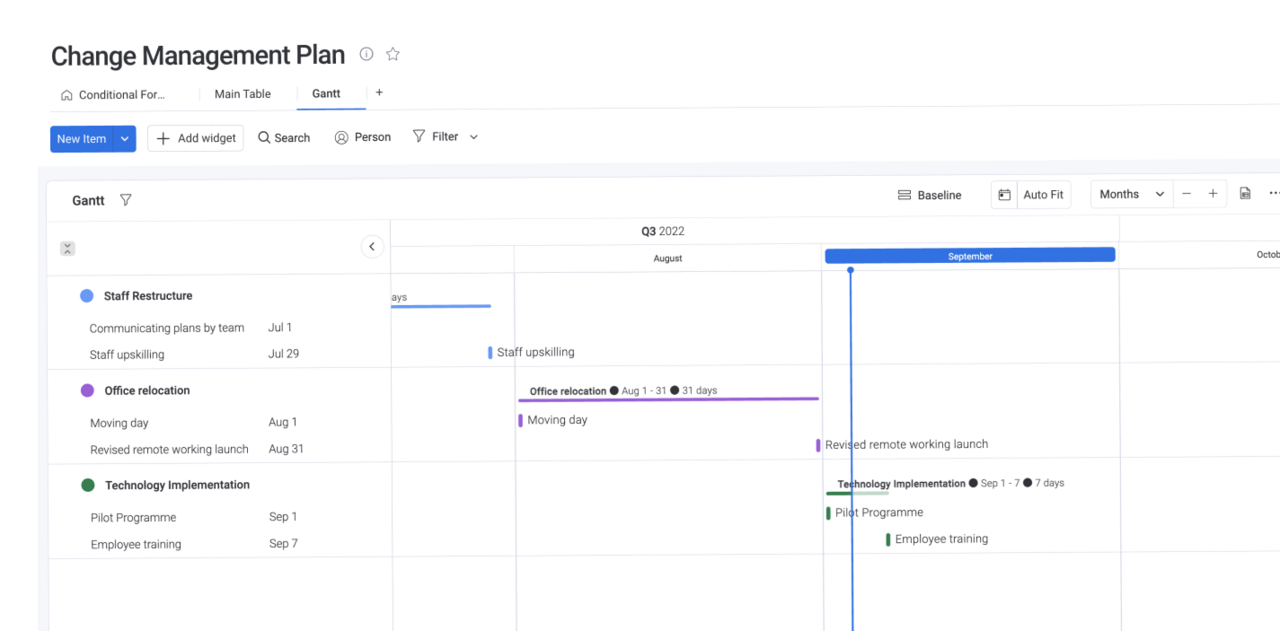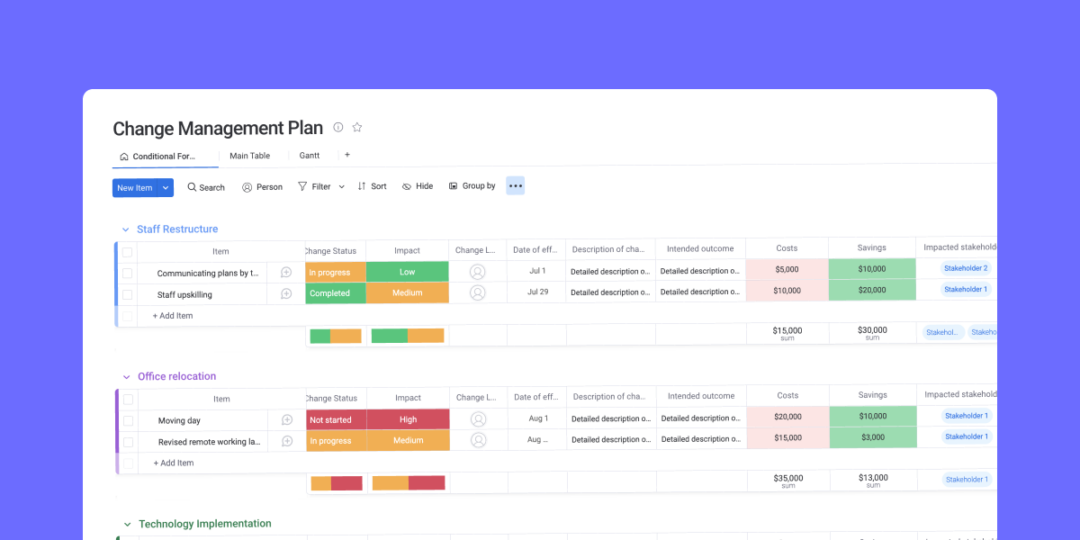The importance of looking ahead with impact analysis
Blog: Monday Project Management Blog

Project and business success and longevity are directly related to the decisions stakeholders make. In times of crisis or transformation, the stakes of making the right decision are dramatically higher. In short, if you want a bright and shiny future for your business, it’s essential to understand the impacts of the choices you make in the present. Impact analysis is how you understand the future impact of decisions.
Impact analysis is a method used to assess the effects — expected and unexpected — an event has on a project or business. Simply put, it’s a process of analyzing causes and consequences. In this article, we’ll explore practices and processes of impact analysis, including a look at common analysis models and some example templates. Along the way, we’ll see how monday.com can help refine and perfect these techniques for maximum impact.
What is an impact analysis template?
Before diving in, it’s worth mentioning related methods of analysis to clear up any confusion. While all of these models still qualify as impact analysis, they’re used for slightly different purposes:
- Change impact analysis: This type of analysis evaluates the consequences, both positive and negative, of making a significant change in the conduct of an organization. A good example would be a company rebranding.
- Business impact analysis: This analysis focuses on identifying and analyzing unexpected events that could significantly impact a business’s profitability. Examples are project delays, supply chain incidents, or the loss of key clients.
Despite the slight differences, both serve the same purpose, which is assisting stakeholders in making decisions that impact the future of the organization. Regardless of the method used, quality impact analysis helps portend future events and provides insight into possible solutions when those events are problematic. In this context, an impact analysis template is an outline used to systemize impact analysis. It simplifies the processes of data collection and information evaluation while helping you prioritize and analyze effectively. It’s essentially your guide through the entire process and helps you predict and evaluate difficulties more accurately and effectively. But that’s only part of the reason for using an impact analysis template.
Why use an impact analysis template?
Another reason to leverage impact analysis is that stakeholders can design strategies for dealing with problems that aren’t uncommon, but usually infrequent. Analyzing the impact of a major equipment malfunction or employee reactions to a major policy change aren’t lightning strikes, but they likely aren’t happening so frequently that the business should hire an impact analyst. In short, a manager’s ability to provide adequate responses to new events, whether they’re planned or random, is governed by the quality of their impact analysis template. Good strategy comes from good analysis. And with good strategy, a business can survive any storm. So, apart from the handful of examples listed so far, when should you pull out your template and conduct a thorough impact analysis? Here are a few more examples with a little more detail.
What are some examples of impact analysis?
Organizations can apply impact analysis to just about any potentiality. If they need to alter work dynamics or make a significant structural shift, for example, an impact analysis is a smart move. Conversely, companies vulnerable to issues such as data loss or security breaches should probably do the same.
A factory wants to upgrade its equipment
Imagine the CEO of a widget manufacturer wants to upgrade his business’s equipment to increase production and optimize workflows. The machinery in use is showing its age, so the decision seems reasonable. But without analyzing the impact of the upgrades, a significant investment could provide marginal returns. The manufacturer needs to analyze:
- Financials: How much will new equipment cost and how will the new equipment impact cash flow?
- Production: How much will the new equipment raise production? Likewise, how long will it take to train employees to reach that level?
- Organizational changes: Will the new equipment require shifts in human resources such as layoffs, turnover, or new employees with specialized training?
- Market delivery and performance: What kind of impact will equipment upgrades have on product delivery and what are the market projects for the timetable involved?
The software a company uses for finances shuts down
As an example of an unexpected change, let’s imagine a small tech company left in a lurch when the software they use for billing and finances unexpectedly shuts down. As a small business, it doesn’t have the resources to stop work while the team decides on new software and performs a migration. Meanwhile, they aren’t sending out invoices or processing payments.
Fortunately, the business’s leader noticed problems with their software provider ahead of time, including long gaps between updates and poor support, and analyzed the impact of moving to a new platform. That analysis provided a strategy that helped the team pivot quickly and easily. As you can imagine by now, impact analysis isn’t a simple or quick process. But in these situations, a template can help guide teams through the process of data collection, assessment, and analysis and set them on the trail to the best possible decision.
Impact analysis templates on monday.com
Understanding the impact unplanned events have on your projects and business requires bringing lots of accurate data together and analyzing it. To do that, you need a single source of truth for all your data — a Work OS that integrates the data from all your existing tools and provides the capabilities to mine that data for insights. With monday.com, you can bring all your business processes, workflows, and data together under one digital roof. Intuitive task boards make analyzing potentialities second nature. And with dozens of highly-customizable templates and countless integrations, workflow transformations are effortless.

The flexibility a Work OS like monday.com gives you means your team can adapt quickly to changes both planned and unplanned and land on their feet. With our Change Management Template, organizations facing challenging transformations can systemize their transition processes while gaining full control over timelines, per-project ownership, costs, and savings. When impact analysis necessitates big organizational shifts, you’ll need the right tools to help make those changes happen gracefully.
Related templates on monday.com
Impact analysis helps teams and stakeholders gain clarity on the qualitative and quantitative outcomes of a potential problem. But it’s only one component of the wider risk management process. Accurate impact analysis depends on the ability to identify risks and see projects from a big-picture perspective. These templates can help with just that.
Program risk register template
Risk management is an integral part of project management. Identifying, cataloging, and analyzing risks before they happen is the best defensive strategy for any project. With our Program Risk Register Template you can record, categorize, and evaluate risks before they happen. It includes probability, response cost, and risk level columns so you can analyze project threats at a glance and make an accurate action plan.
Project portfolio management template
Impact analysis and risk assessment are crucial to project success, especially for stakeholders managing a diverse portfolio of projects that span multiple teams and departments. With our fully customizable Project Portfolio Management Template, keeping tabs on your entire portfolio couldn’t be simpler. This advanced template gives project managers the ability to analyze work processes, manage risks, and monitor project strategies from the wide perspective necessary to spot problems long before they materialize.
Frequently asked questions
Interested in learning more about impact analysis? Here are the questions we see the most along with their answers.
What is a BIA?
A business impact analysis forecasts the financial and operational impact of the loss in business functions. It’s integral to a business continuity plan as the process for conducting a BIA involves identifying mission-critical business processes and simulating scenarios where one or more of those processes are disrupted. This helps businesses plan for worst-case scenarios as well as identify areas of risk where a proactive measure is necessary.
How do you write an impact analysis report?
Impact analysis comes in a variety of forms, but creating a report follows these general guidelines:
- Determine the scope: The first step to impact analysis is determining a scope. For example, your scope might be understanding the impact of the loss of a certain vendor, business process, or even a key team member.
- Gather lots of data: Next, you need to gather data relevant to your scope. This includes all information gathering, be it interviewing colleagues, competitive research, or hard research numbers.
- Analyze the data: With a large set of data, you can start organizing, categorizing, and analyzing what you’ve collected to understand the wider perspective of your scope and goal.
- Draft your findings: Write a document of your findings, including your hypothesis on the impact and supporting information. Once it’s drafted, you’ll share it with key stakeholders for feedback and approval.
- Write an impact analysis summary: Write an impact analysis summary, which you’ll use as a call to action for your team and business leadership.
Identify, measure, and plan for impacts before they happen
Impact analysis requires perseverance and diligence. It depends on the continuous collection of data, consistent analysis, and planning for the unplanned. But when teams and stakeholders have the tools and processes in place to look further ahead and imagine potentialities — both good and bad — the benefits are immense. An impact analysis template is a perfect place to start for teams seeking proactivity.
The post The importance of looking ahead with impact analysis appeared first on monday.com Blog.
Leave a Comment
You must be logged in to post a comment.








